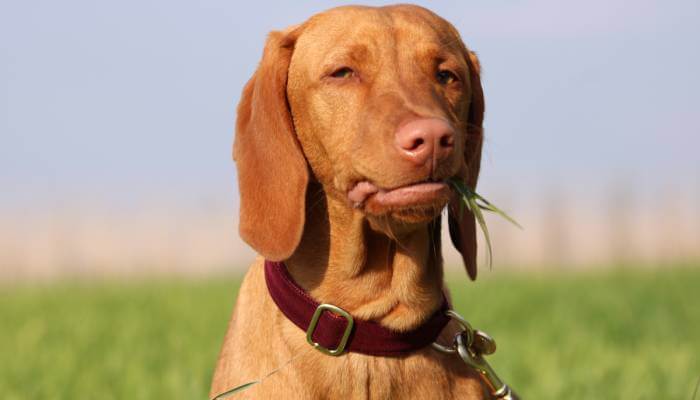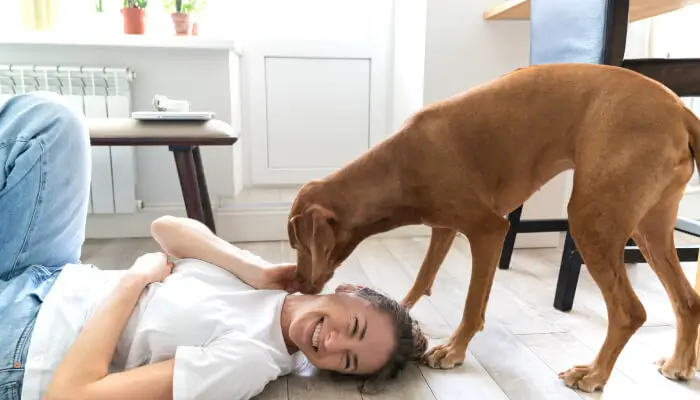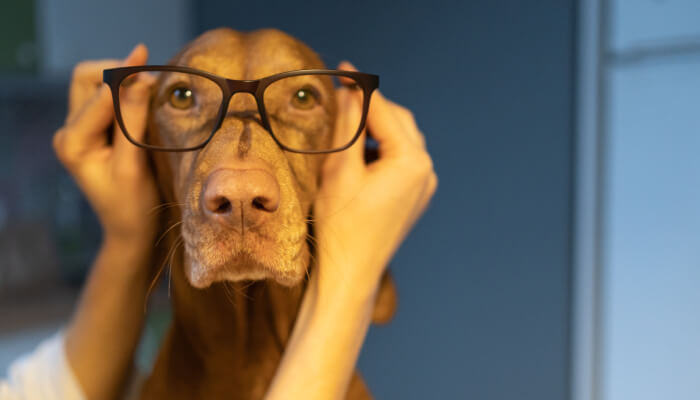Vizslas are a medium-sized, slender hound that is one of the fastest dogs in the world. Along with this, these dogs’ impeccable smelling ability, intelligence, and beautiful skin coat can’t go unnoticed. Don’t you think so? Although I won’t deny that Vizslas are adorable ever since birth. But still, their appealing coat needs to grow for a period of time. So at what age do you think Vizslas get their full coat?
Being a popular dog breed, Vizslas are undoubtedly a familiar name in households. However, many people don’t know about them because Vizslas often have a full coat by the time they are 3 years old. And the impact of diet, exercise, grooming, health, and environment on the development of their skin coat.
So, this article will discuss what factors contribute to Vizslas’s age getting their full coat and when they typically reach adulthood.
What Age Do Vizslas Get Their Full Coat?
Vizsla breed has two coats. The undercoat is short and sleek, while the topcoat is a medium to long length with lots of feathering on his legs, ears, tail, and face. In addition, it has coarse, thick hairs that provide insulation and protection from the elements.
The full coat, or topcoat, is of medium to long length with lots of feathering on his legs, ears, tail, and face. It does not shed as easily as the undercoat.
The coat of Vizsla starts growing as early as six weeks old and will be full by the time they are four to six months. However, sometimes it even takes them two years before they get the full coat.
Do Vizslas Have An Undercoat?
Yes, Vizslas do have an undercoat. The undercoat is a layer of short, fine hairs that lie beneath the outer coat, and it helps to provide insulation.
Usually, the undercoat of these dogs is soft and wooly. It is not as noticeable in the summer due to lack of air circulation and will be more apparent during winter. When the Vizsla’s undercoat is shed, it leaves a layer of longer hair that we refer to as their outer coat.
What Are Factors That Will Determine The Coat Quality Of Vizsla?
To get a Vizsla with a full coat, they need three things: an environment where the temperature is cool enough for them to grow their thick hair (these dogs come from Central Asia), genetic predisposition, and time.
Besides this, the factors that determine the coat quality of Vizsla are genetics, age, environment, and nutrition.
Genetics Determine The Coat Quality Of Vizsla
The genetic makeup of Vizsla plays an important role in determining the quality of their coat. If your Vizsla has a short coat, it is more likely that their offspring will have the same traits. Over time this trait can become common in these dogs and may eventually lead to short coats.
Moreover, the offspring always look-alike like either of their parents. So, it is not surprising that a short-coated Vizsla will have offspring with the same coat. It is also possible for long-haired Vizslas to give birth to puppies with shorter coats and vice versa.
Age And Full Coat Of Vizslas
As Vizslas get older, all the body functions decline, including the production of essential oil. As a result, the color of their coats can also change and the thickness of the fur.
By two years old, a Vizsla should have thickened to its full adult coat. However, after full growth, it is normal for them to lose some or all of this hair during periods when they are shedding their coat. So, the quality of your dog’s coat might degrade with age.
So, if you have a Vizsla older than two years old, it isn’t much of a surprise if it has gray, thinner, and rough hair.
Environment Determine The Coat Quality Of Vizsla
A Vizsla’s coat quality will vary depending on the environment in which they live. For example, if a Vizslas lives in an area with low humidity, their undercoat won’t be as dense or thick because it compensates for high air temperatures and dry conditions. Conversely, if a Vizsla lives in an area with high humidity and rainy conditions, the undercoat will be denser because it compensates for constant moisture.
Furthermore, an environment with too much pollution and toxins result in premature graying and makes your dog’s coat thinner, rough, and brittle.
Nutrition And Age Of Full Coat In Vizslas
Nutrition and the diet your Vizsla gets will influence the quality of its coat. What a Vizsla eats regularly will affect how healthy their skin and fur are, which in turn can lead to an oil or dry coat that may be dull or matt-looking.
As the owner of your puppy, the best way for you to determine what diet might work well for them is to visit your veterinarian. They can help recommend a diet for the Vizsla that will keep it healthy and its coat looking great and give you tips on how often you should bathe and groom them.
The vet may also suggest natural supplements like Omega-three fatty acids to add to your pup’s food to make it healthier.
Exercises
Like most dog breeds, Vizsla also needs daily exercise to remain healthy, fit, and active. Lack of proper exercise might cause various health issues in your dog. As a result, it disturbs the body’s functions.
And this finally leads to degradation of quality od skin coat. Besides this, medication to resolve some health issues has side effects that affect the coat of your Vizsla. Usually, the medicines are antithyroid, corticosteroids, NSAIDs, and spaying or nurturing. Thus, it is best to exercise with your Vizsla if you want shiny, soft, and smooth fur.
Grooming
The coat quality of Vizslas is based on the grooming that they receive. When you groom your dog, it usually helps reveal hair growth patterns and characteristics that might not be clear otherwise. In addition, the more you brush your dog during its lifetime, the better its coat will grow in general. Thus, professionals recommend brushing your Vizsla’s skin coat daily.
Further, Vizslas also need regular bathing at least once a week. Bathing removes dirt and grime, odor-causing bacteria, fungus, and other irritants. It also helps to reduce shedding because the dog will lose less hair during a bath.
The more often you bathe your Vizsla, the finer its coat quality will be. And brushing it regularly with a rubber curry brush helps to remove loose hair and distribute skin oils.
Until With Age Will A Full Coat Last In Vizslas?
In a Vizsla, the full coat will last until they start to show signs of matting. It can be anywhere from two years old-five years old that you’ll notice that your dog is starting to lose their undercoat, and there’s not as much hair on top. What might happen at this point is you have to give them a haircut, and then they’ll grow their full coat back in.
It’s basically right around the time you see them starting to look like a poodle, which is not what we’re going for at all! So what you have to do at this point is to groom your dog every six weeks or so until they start growing new hair.
During new hair growth, sometimes the hair grows longer in certain places that disturb the regular function of Vizsla. Thus, it is best to trim those hairs regularly.
How Often Should You Bathe A Vizsla?
Many people are under the incorrect impression that Vizslas require baths regularly. What many don’t know is only to bathe your dog when they need it, or if you want them to have an extra-special bath; certain factors will determine whether or not your Vizsla needs bathing: And they are:
- The type of environment your dog is in (i.e., dirt, mud, clean)
- The length and thickness of their fur
- Health condition
- The intensity of daily physical activity
- Kind of food Vizsla eat
However, regular bathing will strip a dog’s coat of all protective oils and make it more prone to external parasites. Thus, it is best to bathe them at least once a week.
What Should You Avoid If You Want Your Vizslas Full Coat?
Parenting and grooming a pet is a hectic job. Although Vizslas are easy-going dogs, still, carelessness in grooming will be fatal in this case. Moreover, some things you should avoid if you want a full coat in Vizsla are as follows:
- Never bathe them with human shampoo.
- Don’t forget to use a conditioner after bathing.
- Brush the skin coat daily.
- Avoid using combs, brushes, and nail clippers.
- Do not shave them to make their coat long.
- Make sure your Vizsla’s hair is dry after bathing.
- Always use dog based blow-dryer.
What Will Happen If You Fail To Bathe Your Vizsla?
A dog’s coat is an integral part of its identity. What often sets one breed apart from another are the type and length of hair they have and how that fur affects their appearance. Even different members within a single family have variations in their coats. So, it is crucial to care for the skin coat.
But, if you fail to give regular bath to your Vizsla, it will have the following consequences:
- The skin starts to produce more oil and sweat as a result of the increased heat.
- The dog starts to smell bad.
- Bacteria and yeast start to grow, increasing the likelihood of skin irritation.
- The dog’s coat starts to look dull because of improper grooming.
- Since pets are much more sensitive than humans when temperature changes, they will be prone to sunburns if you fail to clean their fur regularly from dirt or debris.
- It will have a dull and lifeless coat.
- Your pup’s hair may fall out or break off as they try to lick themselves clean, which can lead to skin infections.
Conclusion
Typically, Vizslas will get their full coat when they are one year old. However, some may not have a complete coat until two years of age or older. The factors that determine the quality of your dog’s fur include genetics, diet, and environment. There is no hard-set rule as to how often you should bathe a vizsla. But it can be anywhere from once every month to three times per week. And this depends on the level of dirtiness in your home and outside where your dogs play. I hope this article has been helpful for those who were wondering what age do vizslas get their full coat? Thank you.




